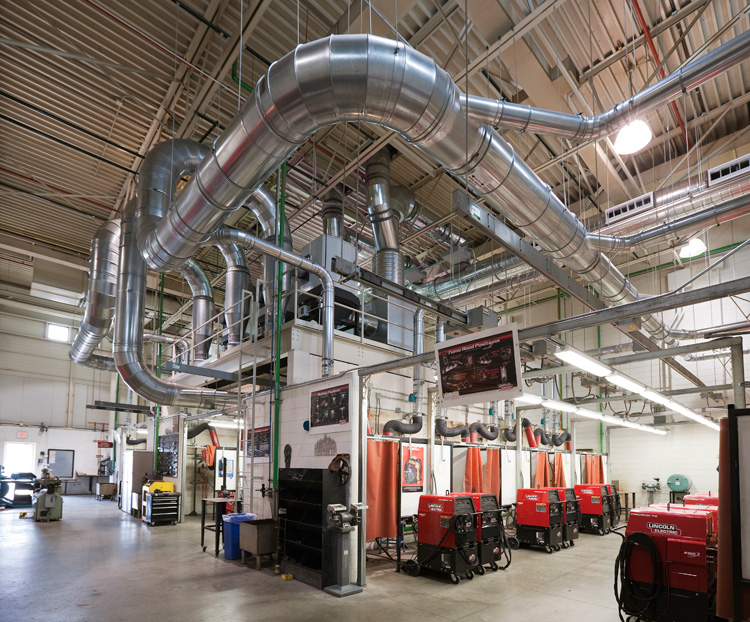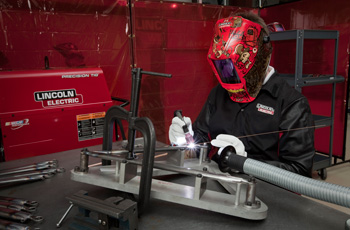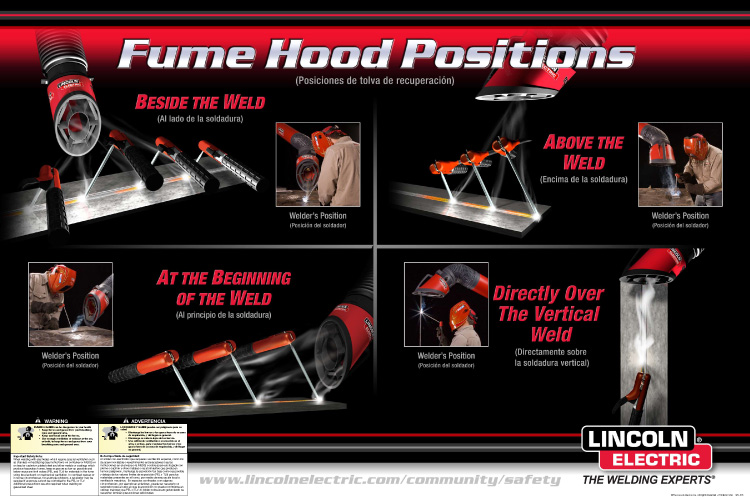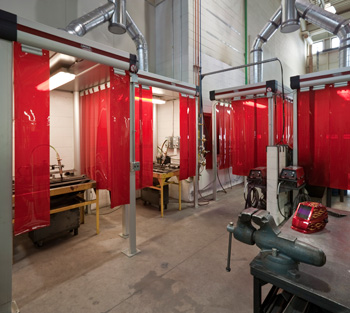Fume Extraction: Not a One-Size-Fits-All Decision
by Deanna Postlethwaite
Marketing Manager, Automation Division
Welding applications are diverse and vary in location, size, scope, as well as a number of other variables. As such, the proper extraction of welding fume is not a one-size-fits-all solution. To make the right choices, a knowledgeable team is necessary to evaluate multiple variables and choose the weld fume control system that will work right for you and your personnel.

$name
Shop-wide central system showing low vacuum fume extraction nozzles in a number of welding booths.
In the process of choosing weld fume control equipment, some decisions can be made on the front end that may be beneficial in the long run. A knowledgeable and conscientious contentious equipment supplier can assist you in these discussions and help you make the right equipment choice.
The first step in this process is to have a systematic measurement of worker exposure performed by a certified industrial hygienist to establish a baseline measurement of worker exposure. With that data, you then can conduct a review of exposure and regulatory requirements, consumable labeling and consumable material data safety sheets for your application.
Engaging the EH&S team at your facility in this process to ensure you have a baseline evaluation is a key step in choosing a weld fume extraction solution. Suggested reading and reference material can be obtained from the American Welding Society at http://www.aws.org or by contacting the AWS at 1-800-854-7149.
Next, evaluate your welding process for changes that can be made to reduce fume. Reviewing alternative welding processes (e.g. switching from FCAW to GMAW-pulsed) and shielding gases (e.g. switching from a straight CO2 to a tri-mix Ar, CO2, O2 blend) can help identify any opportunities to reduce the welding fume generated, not to mention the upfront cost of the fume extraction equipment solution you choose. The lesser amount of fume generated, the easier it will be to control. A supplier with expertise in welding consumables, welding equipment, welding processes and fume extraction solutions can provide the depth of knowledge needed to assist in making these decisions.
Using the above data, the next crucial step in determining which type of fume extraction solution and design is best suited to your specific application is a site evaluation. In order for a supplier to properly determine the right solution, they will embark upon a site assessment, which is necessary to obtain details on specific application variables that need to be considered.
$name
This process allows both the supplier and your team to work together to identify the optimum fume extraction solutions for different applications (e.g. a fume extraction welding gun might be best suited for areas where large parts with multiple welds are being fabricated, whereas stations where a small part with a straight weld are being fabricated might be better suited to a portable or mobile weld fume control system).

$name

$name
Examine alternative welding processes to determine if can move to a process that produces less welding fume.

$name
Weldments covering a large area with multiple welds may best be served with a fume extraction welding gun, while small parts with straightline welds can typically be handled by a portable or mobile low vacuum fume control system.

$name
A push/pull system can be most effective to improve general workplace air quality or when fabricating large weldments.
These site assessments also allow the team to identify areas in the plant that would require more complex, customized solutions, such as automating a welding process and isolating the area from employee exposure or general ventilation in an area where large welded parts may contribute a greater amount of welding fume into the shop air. The final plan for your fabrication facility may incorporate a number of different solutions that are tailored to each of your applications, whether it is welding, cutting or grinding
$name
Another step in any welding fume evaluation is the education and implementation of safe work practices. Installing weld fume extraction equipment is not effective if the welding operators do not use safe welding practices and if the proper use and maintenance of the equipment is not consistently taught and performed.
Just as electrical safety and chemical safety are essential training initiatives in fabrication plants, welding safety education should also become a key focus, if it isn’t already. Some suppliers offer a range of materials and services to assist you to implement a safe work practice plan from proper equipment usage posters to interactive welding safety lessons that can be easily incorporated into your company’s training plans.

$name
Some fume control equipment suppliers produce posters, educational materials and resources regarding systems, practices and regulatory issues.
Other fume control solutions can be used to address the requirements of almost any application.
The steps above are critical in selecting and implementing the best fume extraction solution for your application(s). The information developed and decisions made help ensure that the equipment you select is the best suited to your application and that your team has the support and training needed for an effective solution. In the end, this process will create a work environment that is cleaner, safer and more productive.
$name

$name
Modular hood systems are recommended for fixed work stations.

$name
Downdraft tables provide a table top work surface while pulling fume away from the operator.
